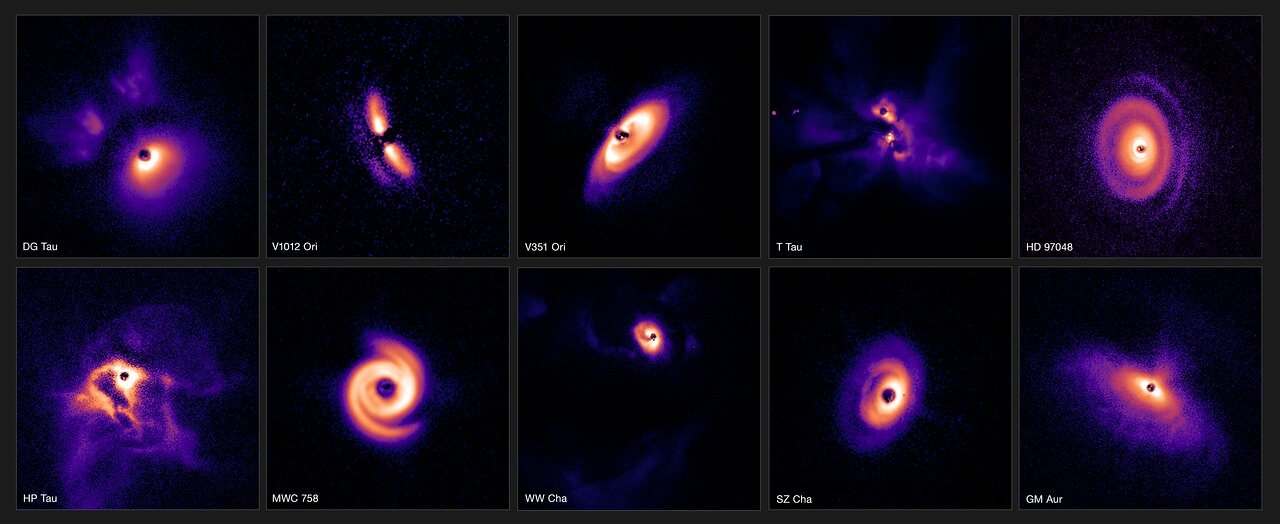Astronomers using the Very Large Telescope in Chile have now completed one of the largest surveys ever to hunt for planet-forming discs. They were able to find dozens of dusty regions around young stars, directly imaging the swirling gas and dust which hints at the locations of these new worlds.
Just like the wide variety in the types of exoplanets that have been discovered, these new data and stunning images show how protoplanetary systems are surprisingly diverse, with different sizes and shapes of disks.
In research presented in three new papers, researchers imaged 86 young stars and found 62 of them had a wide range of star-forming regions surrounding them. The astronomers say this study provides a wealth of data and unique insights into how planets arise in different regions of our galaxy.

“Some of these discs show huge spiral arms, presumably driven by the intricate ballet of orbiting planets,” said Christian Ginski, from the University of Galway, Ireland, and lead author of one of the three papers published in Astronomy & Astrophysics.
“Others show rings and large cavities carved out by forming planets, while yet others seem smooth and almost dormant among all this bustle of activity,” said Antonio Garufi, an astronomer at the Arcetri Astrophysical Observatory, Italian National Institute for Astrophysics (INAF), and lead author on another paper.
As of this writing, there are 5595 confirmed exoplanets that have been discovered, with more than another 5000 candidate planets yet to be confirmed. From these strange new worlds, we’ve found a wide variety of planetary systems, very different from our own. In order to understand this variety, a large international group of astronomers combined forces to observe the dust- and gas-rich discs that envelop young stars, where the very early stages of planet formation takes place.

The 86 stars studied were in three different star-forming regions of our galaxy: Taurus and Chamaeleon I, both about 600 light-years from Earth, and Orion, a gas-rich cloud about 1,600 light-years from us that is known to be the birthplace of several stars more massive than the Sun.
In total, the team observed 43 stars in the Taurus region, and found planet-forming disks around 39 of them; 20 stars in the Chamaeleon I region, detecting discs around 13; and 23 stars in the Orion region, with planet-forming discs around 10 of them.
They used the Spectro-Polarimetric High-contrast Exoplanet REsearch instrument (SPHERE) mounted on ESO’s VLT, and were able to image discs around stars with masses as low as half the mass of the Sun, which are typically too faint for most other instruments. Additional data for the survey were obtained using the VLT’s X-shooter instrument, which allowed astronomers to determine how young and how massive the stars are. The Atacama Large Millimeter/submillimeter Array (ALMA), also in Chile provided data on the amount of dust surrounding some of the stars.
One of the key findings from the observations of young stars in Orion showed that stars that are in systems with two or more stars were less likely to have large planet-forming discs. The astronomers said this is a significant result given that, unlike our Sun, most stars in our galaxy have companions. Additionally, they found that any uneven appearance of the planet-forming discs suggests the possibility of massive planets embedded within them, which could be causing the discs to warp and become misaligned.

The researchers say they will continue to study the data gathered, but so far the beautiful images and insightful data have provided a wealth of information to help study the mysteries of planet formation.
“It is almost poetic that the processes that mark the start of the journey towards forming planets and ultimately life in our own Solar System should be so beautiful,” concludes Per-Gunnar Valegård, a doctoral student at the University of Amsterdam, the Netherlands, who led the Orion study.
Further reading:
ESO press release
Papers on Chamaeleon, Taurus, Orion


If they had waited until May, they could have released this to celebrate the 10th anniversary of SPHERE! 🙂